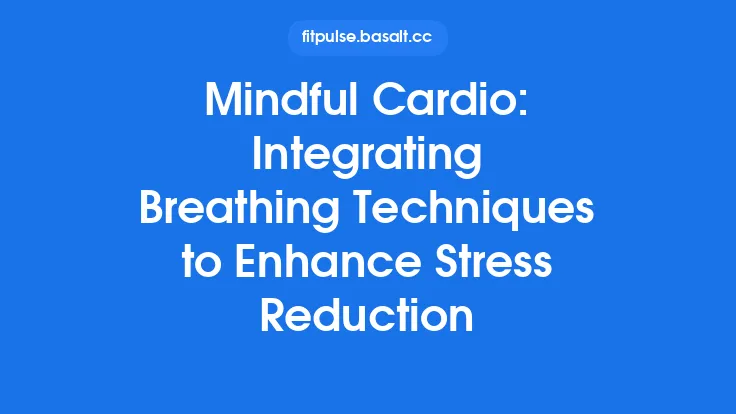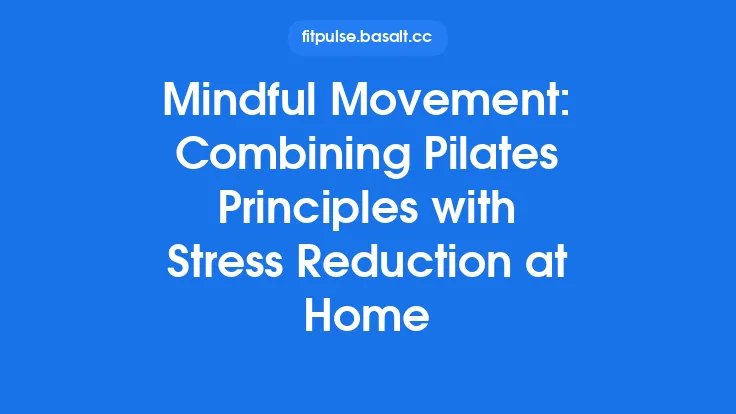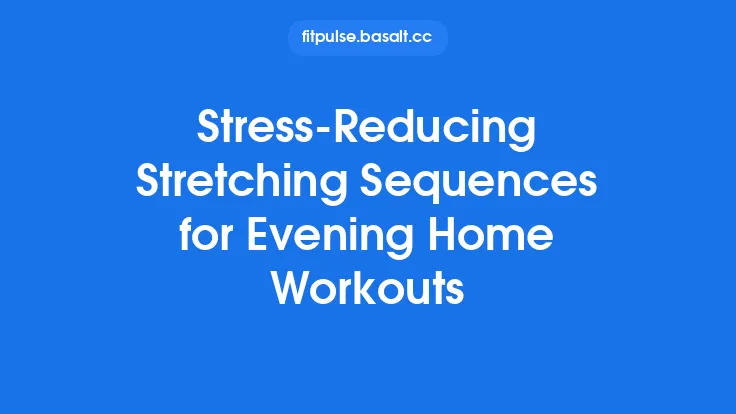Integrating mindful breathing into your home workouts can transform a routine that feels purely physical into a holistic practice that sharpens focus, stabilizes the nervous system, and enhances overall performance. By deliberately pairing breath with movement, you create a feedback loop where each supports the other, leading to more efficient muscle recruitment, better endurance, and a calmer mind—qualities that are especially valuable when you’re training in the limited space of a home environment.
Understanding Mindful Breathing: Foundations and Benefits
Mindful breathing is the intentional regulation of the breath while maintaining present‑moment awareness. Unlike ordinary, automatic breathing, mindful breathing invites you to observe the inhale‑exhale cycle, notice the sensations in the chest and abdomen, and adjust the pattern to suit the demands of your activity.
Key benefits for home exercisers
| Benefit | How it Helps Your Workout |
|---|---|
| Improved oxygen delivery | Optimized diaphragmatic breathing expands lung capacity, allowing more oxygen to reach working muscles. |
| Enhanced core stability | The act of controlling breath engages the transverse abdominis and pelvic floor, providing a natural “corset” for lifts and planks. |
| Reduced perceived exertion | A steady breath rhythm can lower the rating of perceived effort (RPE), making intense sets feel more manageable. |
| Stress regulation | By stimulating the parasympathetic nervous system, mindful breathing curtails the cortisol surge that often follows high‑intensity sessions. |
| Better mind‑muscle connection | Focusing on breath anchors attention, sharpening proprioception and ensuring you’re moving with intention rather than momentum. |
The Physiology of Breath: How Breathing Influences Performance
- Respiratory Mechanics – The diaphragm, intercostal muscles, and accessory muscles (scalenes, sternocleidomastoids) work together to create negative intrathoracic pressure. When you breathe diaphragmatically, the diaphragm contracts downward, increasing thoracic volume and allowing a larger tidal volume (the amount of air moved per breath). This reduces the work of breathing during demanding sets.
- Gas Exchange Efficiency – A deeper, slower inhale increases alveolar ventilation, improving the diffusion gradient for oxygen (O₂) and carbon dioxide (CO₂). Efficient CO₂ clearance prevents the “air hunger” that can trigger premature fatigue.
- Heart Rate Variability (HRV) – Controlled breathing, especially at a cadence of ~5–6 breaths per minute, can boost HRV, a marker of autonomic balance. Higher HRV correlates with faster recovery and better adaptation to training stress.
- Intrathoracic Pressure and Core Activation – The Valsalva maneuver (a forced exhalation against a closed airway) is often used during maximal lifts to stabilize the spine. Mindful breathing teaches you to modulate intra‑abdominal pressure deliberately, allowing you to employ a Valsalva‑like bracing when needed while still maintaining oxygen flow.
- Neurochemical Effects – Slow, rhythmic breathing stimulates the vagus nerve, releasing acetylcholine and promoting a calm mental state. This neurochemical shift can improve focus and reduce the mental fatigue that sometimes accompanies long home workout sessions.
Choosing the Right Breathing Technique for Different Exercise Modalities
Strength Training
- Controlled Exhalation on Effort – For most resistance exercises (e.g., squats, deadlifts, push‑ups), exhale during the concentric (lifting) phase and inhale during the eccentric (lowering) phase. This pattern helps maintain intra‑abdominal pressure and prevents excessive intra‑thoracic pressure spikes.
- Modified Valsalva for Maximal Loads – When attempting a personal record, a brief, intentional Valsalva (hold breath at the bottom of the lift) can provide maximal spinal stability. Immediately after the lift, resume a controlled diaphragmatic exhale to re‑oxygenate quickly.
Cardiovascular Workouts
- Rhythmic Breath‑to‑Step Ratio – Align your breath with your stride or pedal cadence. For moderate‑intensity jogging, a 2:2 ratio (inhale for two steps, exhale for two steps) maintains a steady oxygen supply without over‑breathing.
- Box Breathing for Interval Recovery – During short rest periods in interval training, practice a 4‑second inhale, 4‑second hold, 4‑second exhale, 4‑second hold pattern. This quickly restores CO₂ balance and steadies heart rate without resorting to the 4‑7‑8 method.
Mobility and Functional Movements
- Diaphragmatic Expansion in Dynamic Stretches – While performing hip openers, shoulder circles, or thoracic rotations, inhale deeply to expand the rib cage, then exhale to deepen the range of motion. This encourages fluid movement and reduces tension in surrounding musculature.
Practical Steps to Incorporate Breath Awareness into Your Routine
1. Pre‑Workout Breath Preparation
- 5‑Minute Breath Reset – Sit or stand tall, place one hand on the abdomen, and practice diaphragmatic breathing: inhale through the nose for a count of 4, feel the belly rise, exhale through the mouth for a count of 6. Repeat for five minutes to prime the nervous system.
- Set a Cue – Choose a simple verbal cue (“inhale,” “exhale”) or a visual cue (a timer beep) that will remind you to check your breath at the start of each set.
2. Intra‑Workout Breath Cues
- Synchronize with Reps – For bodyweight circuits, count aloud: “Inhale, squat; exhale, jump.” This keeps the breath aligned with movement tempo.
- Use a Metronome or Music Beats – Set a metronome at 60–80 BPM and breathe in time with the beats. This is especially useful for kettlebell swings or dumbbell snatches where rhythm is crucial.
3. Post‑Workout Breath Reset
- Cool‑Down Diaphragmatic Flow – After the final set, lie on your back with knees bent, place a light weight (e.g., a small pillow) on the abdomen, and continue slow diaphragmatic breaths for 2–3 minutes. This aids in flushing metabolic waste and signals the body to transition into recovery mode.
Designing a Breath‑Centric Home Workout Plan
Sample 30‑Minute Session
| Time | Activity | Breath Focus |
|---|---|---|
| 0:00‑5:00 | Breath Reset (diaphragmatic) | Full abdominal expansion, 4‑6 count |
| 5:00‑12:00 | Circuit (3 rounds): 10 goblet squats, 12 push‑ups, 15 alternating lunges | Inhale on descent, exhale on ascent/press |
| 12:00‑15:00 | 2‑minute jump rope intervals (30 s on, 30 s off) | 2:2 step‑breath ratio |
| 15:00‑22:00 | Strength block: 4×5 dumbbell deadlifts, 4×5 overhead press | Inhale on reset, exhale on lift; brief Valsalva on heavy set |
| 22:00‑25:00 | Core finisher: 3×30 s plank with breath‑count (inhale‑hold‑exhale‑hold) | Controlled diaphragmatic breathing |
| 25:00‑30:00 | Cool‑down stretch + breath flow | Slow diaphragmatic exhale, 6‑second count |
Progression Strategies
- Increase Breath‑Load Ratio – As you become comfortable, add an extra inhale or exhale per set (e.g., shift from 2:2 to 3:2 step‑breath ratio in cardio).
- Introduce Breath Holds – For strength days, incorporate a 2‑second hold at the end of the eccentric phase before the inhale, sharpening intra‑abdominal pressure control.
- Layer Complexity – Combine two breathing patterns within a single circuit (e.g., box breathing during rest, rhythmic breathing during work) to train adaptability.
Common Pitfalls and How to Overcome Them
| Pitfall | Why It Happens | Solution |
|---|---|---|
| Shallow Chest Breathing | Tendency to “talk” while exercising, especially during high‑intensity bursts. | Practice diaphragmatic breathing in low‑intensity warm‑ups; place a hand on the abdomen to feel the rise. |
| Holding Breath Too Long | Misinterpretation of the Valsalva technique, leading to dizziness. | Set a timer for 2‑second holds max; immediately resume controlled exhale after the lift. |
| Over‑Synchronizing to Music | Beats may be too fast, causing hyperventilation. | Choose music with a moderate BPM (60–80) for breath‑aligned sections; switch to a metronome for precise control. |
| Neglecting Post‑Workout Breath Reset | Focus on finishing the workout quickly. | Schedule a mandatory 2‑minute breath reset at the end of every session; treat it as part of the workout. |
| Forgetting Breath Cues | Cognitive load of learning new movements. | Write cue cards or set phone reminders; use visual markers (e.g., a colored mat) to trigger breath checks. |
Tools and Resources to Support Breath Integration
- Breath‑Tracking Apps – Apps like Breathwrk or Prana Breath provide customizable breath cycles and visual guides.
- Wearable Sensors – Devices that monitor respiratory rate (e.g., WHOOP, Oura Ring) can give real‑time feedback on breath depth and consistency.
- Metronome or Rhythm Apps – Simple metronome apps allow you to set beats per minute that align with your desired breath cadence.
- Resistance Bands with Markers – Some bands have color‑coded sections; use them as tactile cues for inhale/exhale phases during band pulls.
- Online Libraries – Reputable sources such as the American Council on Exercise (ACE) publish breathing technique handouts that can be printed and placed near your workout space.
Measuring the Impact: Tracking Breath‑Related Metrics
- Respiratory Rate (RR) – Record breaths per minute during warm‑up, peak effort, and cool‑down. A decreasing RR at a given workload over weeks indicates improved efficiency.
- Heart Rate Variability (HRV) – Use a nightly HRV reading to gauge recovery; consistent breath practice often yields higher HRV scores.
- Perceived Exertion (RPE) Correlation – Log RPE alongside breath pattern notes. Over time, you should notice lower RPE for the same load when breath is well‑controlled.
- Performance Benchmarks – Track strength numbers (e.g., squat depth, push‑up reps) and cardio metrics (e.g., distance covered in a set time). Improvements concurrent with breath integration suggest a causal link.
Document these metrics in a simple spreadsheet or a dedicated fitness journal. Review monthly to identify trends and adjust breath cues accordingly.
Frequently Asked Questions
Q: Do I need special equipment to practice mindful breathing?
A: No. All you need is a quiet space, a timer or metronome, and perhaps a mat for comfort. Optional tools like a breath‑tracking app can enhance feedback but are not required.
Q: How long should each breathing session be?
A: For most home workouts, a 5‑minute pre‑session reset and a 2‑minute post‑session reset are sufficient. During the workout, integrate breath cues into each set; the duration will naturally align with the exercise length.
Q: Can I use mindful breathing while doing high‑intensity interval training (HIIT)?
A: Absolutely. Focus on rhythmic breathing during work intervals (e.g., 2:2 step‑breath) and employ short box‑breathing patterns during the rest periods to recover quickly.
Q: Is it safe to hold my breath during heavy lifts?
A: A brief, controlled Valsalva hold (1–2 seconds) can be safe for maximal lifts if you exhale immediately after the lift. Avoid prolonged breath holds, especially if you have cardiovascular concerns; consult a medical professional if unsure.
Q: Will mindful breathing replace the need for a warm‑up?
A: No. Breath work complements a physical warm‑up. Pair diaphragmatic breathing with dynamic movements (e.g., arm circles, leg swings) for optimal preparation.
By weaving mindful breathing into every phase of your home workout—preparation, execution, and recovery—you create a self‑regulating system that not only boosts physical performance but also cultivates mental resilience. The techniques outlined above are timeless, requiring no fancy equipment or fleeting trends, making them perfect for anyone seeking a sustainable, stress‑reducing edge in their home fitness journey. Embrace the breath, and let it become the silent partner that powers every rep, every sprint, and every stretch.





